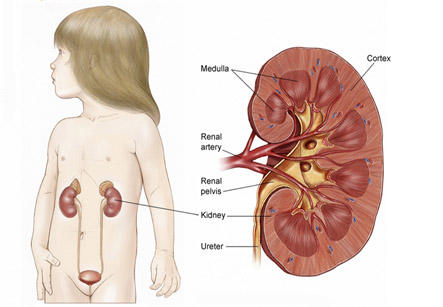Wilm Tumor
Introduction
Wilms’ tumor is a rare cancer of kidney which primarily affects children. This is also known as nephroblastoma. Wilms’ tumor is the most common cancer of the kidneys in children. Wilms’ tumor commonly occurs in just one kidney, though it can sometimes be found in both kidneys at the same time.
Wilms’ tumor most often affects children in the age group of 3 to 4 and becomes much less common after age 5.
Improvements in the diagnosis and treatment of Wilms’ tumor have improved the outcomes (prognosis) for children with this disease. The outlook for most children with Wilms’ tumor is very good.
The causes of Wilms’ tumor have not been found as yet. Doctors know that cancer begins when cells develop errors in their DNA. The errors allow the cells to grow and divide indefinitely and to be immortal when other cells would die. The accumulating cells form a tumor. In Wilms’ tumor, this process occurs in the kidney cells. In some cases, the errors in DNA that lead to Wilms’ tumor are passed from parents to children. In most cases, there is no known connection between parents and children that may lead to cancer.
Iranian specialists have made remarkable achievements in infants' surgeries and Iran is among few countries that have gained access to the latest surgical technologies

Symptoms
Wilms’ tumor does not always cause signs and symptoms. Children with Wilms’ tumor may appear healthy, or there may be:
• Abdominal swelling
• An abdominal mass which can be felt
• Abdominal pain
• Fever
• Blood in the urine
Contact the doctor immediately if you notice any signs or symptoms in the child that worry you. The signs and symptoms associated with Wilms’ tumor are not specific to the condition and are much more likely to be caused by something else.
Wilms’ tumor can occur as part of rare syndromes, including:
• WAGR syndrome. This syndrome includes Wilms’ tumor, aniridia, genital abnormalities and mental retardation.
• Denys-Drash syndrome. This syndrome includes Wilms’ tumor, kidney disease and male pseudohermaphroditism (in this condition, a boy is born with testicles but may exhibit female characteristics).
• Beckwith-Wiedemann syndrome. Symptoms of this syndrome include umbilical hernia, a large tongue (macroglossia) and enlarged internal organs.
Factors that may increase the risk of Wilms’ tumor include:
1. Female sex. Girls are slightly more likely to develop Wilms’ tumor than are boys.
2. Being black. Black children have a slightly higher risk of developing Wilms’ tumor than do children of other races. Children of Asian descent usually have a lower risk than do children of other races.
3. Family history of Wilms’ tumor. If someone in the child’s family has had Wilms’ tumor, then the child has an increased risk of developing the disease.
Wilms’ tumor occurs more frequently in children with certain congenital abnormalities, including:
1. Aniridia. In this condition, the iris or the coloured portion of the eye forms only partially or not at all.
2. Hemihypertrophy. A condition in which one side of the body is noticeably larger than the other side.
3. Undescended testicles. One or both testicles fail to descend into the scrotum from abdomen (cryptorchidism).
4. Hypospadias. The urinary (urethral) opening is not at the tip of the penis, but is on the underside.
Treating the disease
Wilms’ tumor occurs more frequently in children with certain congenital abnormalities.
Standard treatment for Wilms’ tumor includes surgery and chemotherapy. The stage of the tumor and appearance of the cancer cells under a microscope helps to determine whether the child also needs radiation therapy. At this point, the doctor may tell whether the tumor appears to be favourable or unfavourable (anaplastic), depending on the histology of the tissue. Children whose tumours have a favourable histology have better prognosis. However, many children with unfavourable histology also have good outcomes.
Because this cancer is rare, the doctor may recommend that the treatment should be continued at a children’s cancer centre which has experience in treating this type of cancer.
Surgical treatment includes removal of kidney tissue, which is called as nephrectomy. The various types of nephrectomy include:
1. Simple nephrectomy. In this surgery, the surgeon removes the entire kidney. The remaining kidney can compensate for the removed one and takes over the entire job of filtering the blood.
2. Partial nephrectomy. This involves removal of the tumor and part of the kidney which is surrounding it. It is usually performed when the other kidney is damaged or has already been removed.
3. Radical nephrectomy. In this type of surgery, doctors remove the entire kidney and surrounding tissues, including the ureter and adrenal gland. Nearby lymph nodes are also removed.